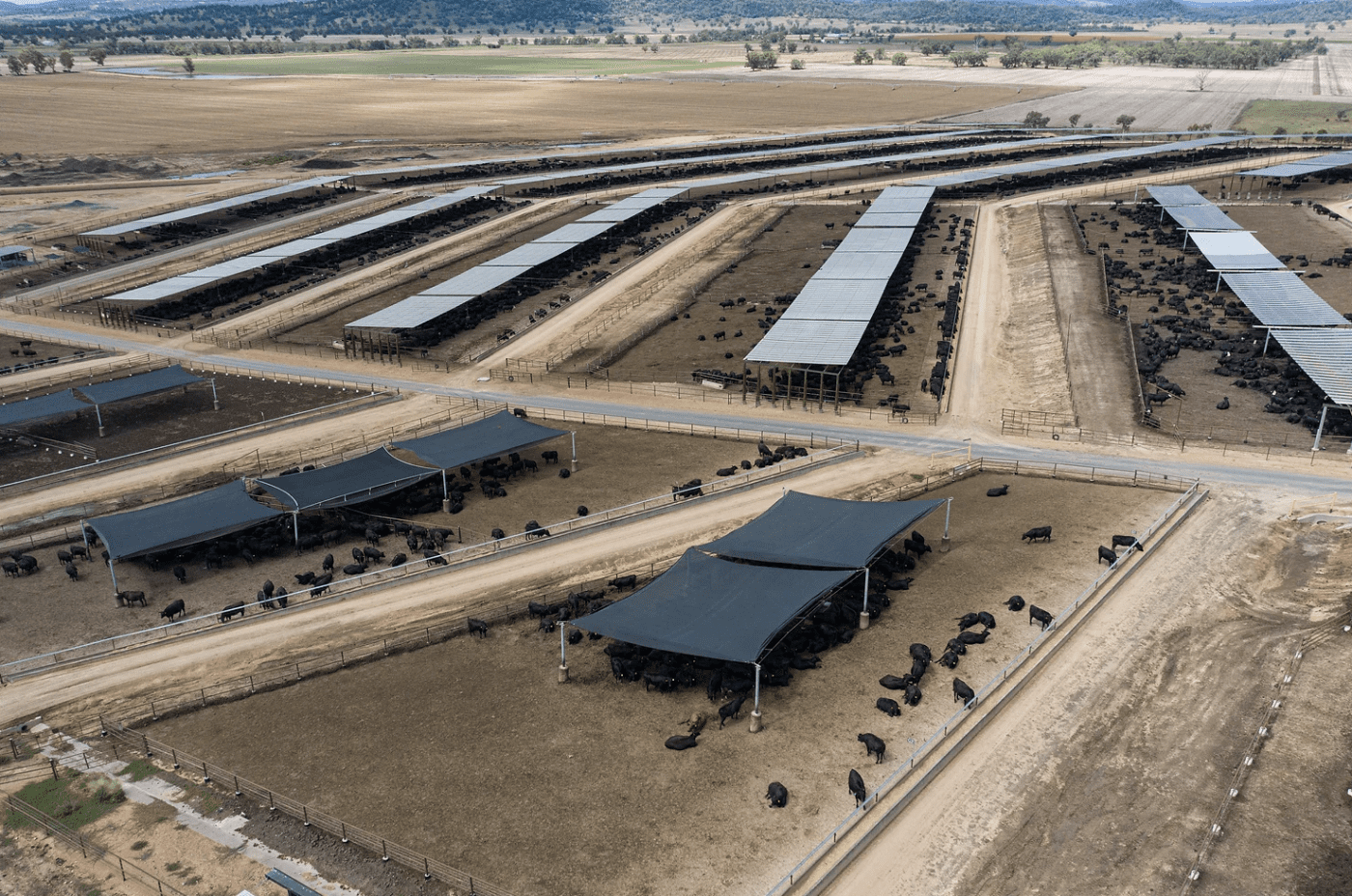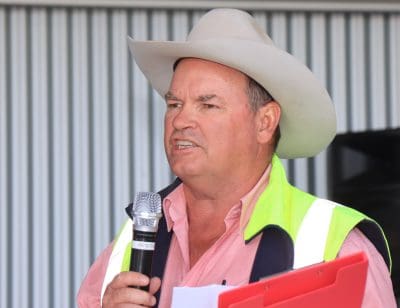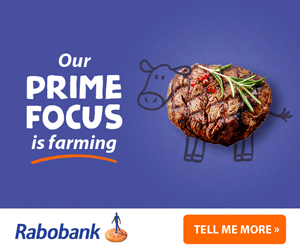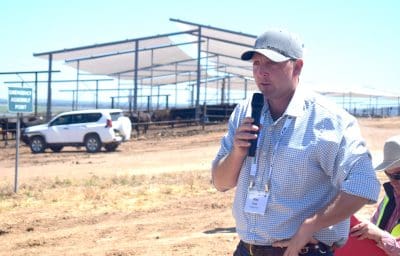
THE managers of two large feedlots in northern New South Wales provided an update on their experiences with shade infrastructure at ALFA’s SmartBeef field day on Thursday.
 Andrew Talbot, general manager of the event’s host feedlot Elders Killara near Quirindi, and Alex Smith, manager of Rangers Valley feedlot on the New England Tablelands, shared their knowledge of working with shade in two different climatic regions.
Andrew Talbot, general manager of the event’s host feedlot Elders Killara near Quirindi, and Alex Smith, manager of Rangers Valley feedlot on the New England Tablelands, shared their knowledge of working with shade in two different climatic regions.
Andrew Talbot said he was proud to be part of an industry that was “on the front foot” with strong progress being made toward facilities installing shade without it being mandated.
“We’re not mandating, we’re not telling people what to do,” he said.
“It doesn’t need to be done through the big stick, it needs to be done by common sense and care for not just for their facility but the broader industry.”
Do cattle like shade?
Answering that question, Mr Talbot pointed out that some breeds such as Wagyu seemed to not really care, adding they are a little “weird”: “We have got a fair few here, and they will still stand outside if it is 42 degrees”.
Alternatively British Breed cattle will clearly seek out shade. “In summer in a 42-degree weather event with a 40-knot breeze coming from Walgett, I’m telling you, 99pc of the cattle are under shade.
“Don’t let anyone tell us that there is no need for shade. We have got to have shade.”
 Shade has been introduced to manage heat events in summer, but feedlots have had to learn how to work with shade during wet winters, as they have experienced over the past three years.
Shade has been introduced to manage heat events in summer, but feedlots have had to learn how to work with shade during wet winters, as they have experienced over the past three years.
Mr Talbot said increased pen cleaning has been an important strategy in response.
“We did that because we know how much impact having shade will enable areas not to dry and you are going to have a problem,” he said.
“Brent Berry, our nutritionist, will say too much mud will wipe performance. You’ve got to get it out.”
He recalled that when Killara hosted a recent visit by the RSPCA, he was asked why the feedlot “didn’t smell”.
“It is because we clean every 60 days,” he said. “We love getting manure out of pens. We have got a great business that then value adds it and we sell it, but I see how much better cattle do when they have got clean pens.”
Both feedlots have documented improved performance of cattle from under shade which has contributed to a faster payback on the capital investment.
A recently installed $1.2 million two-tiered waterproof shade investment in one part of Killara has helped to keep the majority of rainfall off the ground underneath.
“What we have found – trust me when I tell you 0.2-0.5kg a day added ADG (average daily gain).
“And that is driven by added consumption.
“So feed conversions improve dramatically but ADG was massive.”
Mr Talbot said the improved performance should result in a payback of the $1.2m capex investment within 4.5 years.
But he also urged people not to look at it “just on a financial metric”.
“There are other things to consider which are bigger issues,” he said.
The emotional impact on staff after a heat event is considerable , some staff never get over it and leave the industry. It’s painful and particularly hard on younger staff who may have never experienced the stress on livestock caused by an extreme heat event.
“I know that bigger issues don’t always pay the bills and keep the bank manager happy, but financially it does stack up.”
Two feedlots, two climates
Rangers Valley has recently installed a $3.1 million Entegra Ridgeback shed spanning some 440m in length.

Alex Smith from Rangers Valley speaking at the SmartBeef 2023 event at the Killara feedlot.
The feedlot is only about a 3.5-hour drive from Killara but, sitting at 1000 metres above sea level, it is in a different climate, with winter temperatures that can drop to minus 12 degrees C at night, while summer temperatures can still reach high 30s.
While shade is important in summer, the aim during winter, particularly in wet years, is to get as much daylight on pens as possible. Various types of shade were considered before the feedlot settled on a new shed which covers each 60m pen to a depth of 30m.
“So we’re covering half of those pens,” Mr Smith said.
“What we’re trying to do there is put an area in for the cattle that will stay dry, keep water off the pens, and pull water out of our production system and give cattle a dry area there.”
The design gives cattle the freedom to choose what they want to do and whether to move in or out of the shed depending on conditions.
He said that during wet events there was definitely a movement of cattle choosing to use the shed.
At any one time he said there were two thirds under the shed, and a third out, he said. “So we have a minus 10 morning, there will be a third of the pen outside covered in frost, and the rest will be moving in
“So they definitely choose to move and in out, we have seen a lot of that, so that has been good.”
Early results from trials also suggest that cattle with access to woodchip bedding in both the covered and outside parts of their pens were performing in front of cattle without, with much less dag-loads.
Mr Smith said their calculations point to a pay back on the capital infrastructure of the shed within six to seven years.
“But we have done one scenario where it is down to five,” he said. “But even if it is 10, that is still a good payback in our books.”
Other benefits of the shed included the ability to capture water and renewable energy.
Mr Smith said they expect to be able to capture about 12 to 13 megalitres of rainfall from the shed, which can be up to a fifth of the water usage of the cattle under the shed.
Solar could also power the whole feedlot from half the shed, with the potential to create a further additional income source by selling surplus power into the grid in future.
Meat & Livestock Australia also used the session to launch a best practice design and management manual for covered and partially covered housing systems developed for the Australian lot feeding industry, including best available knowledge from around the world on coverage systems along with knowledge gained from a variety of covered housing systems operational in Australia.

Shade from the hot summer sun should be a legal requirement, yes some cattle are quite comfortable sitting in the sun at 35+, however most are not.